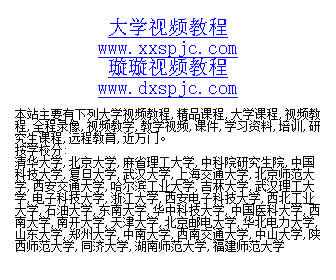![《生物毒理学》(Principles of Biochemical Toxicology, Fourth Edition)第四版[PDF]](http://pic.dxspjc.com/dx_pic/9113012/5126352.jpg)
◎原 名 Principles of Biochemical Toxicology, Fourth Edition
◎出版时间 2008年11月18日
◎国 家 美国
◎类 别 教育科技-医学
◎版 本 第四版
◎语 言 英文
◎文件格式 PDF
◎文件大小 11.7MB
◎页 码 453页
◎作 者 John A. Timbrell
◎内容简介:
这在该领域处于领先地位的教科书对毒性机制进行了研究,特别是在分子和因子方面对毒性研究起到了决定性的影响。新版本更新,以反映到生物化学基础上的最新研究和对药物的不利影响,环境污染,职业危害日益关注。《生化毒理学原理第四版》彻底解释剂量反应关系,处置和代谢,以及外国化合物的毒性反应,并列出了详细的例子,对在毒性机制方面学生首次更容易遇到的问题做出明确的讲解。内容全面、简洁、明快,内容包括概要部分,问题和标准答案,并完全的修正了原作品,作为一个不可或缺的辅助学习和教学服务。
This leading textbook in the field examines the mechanisms underlying toxicity, particularly the events at the molecular level and the factors that determine and affect toxicity. The new edition is updated to reflect the latest research into the biochemical basis of toxicology and the growing concerns over the adverse effects of drugs, environmental pollution, and occupational hazards. Principles of Biochemical Toxicology, Fourth Edition thoroughly explains dose-response relationships, disposition and metabolism, and toxic responses to foreign compounds, and presents detailed examples to make the mechanisms of toxicity more accessible to students encountering the subject for the first time. Comprehensive in scope with a clear and concise approach, the text includes summary sections, questions and model answers, and thoroughly revised artwork that serves as an essential aid to learning and teaching. New to the Fourth Edition:
reorganized sections that cover basic principles followed by sections on different types of toxicity extensive use of examples throughout and numerous explanatory diagrams
new material on risk assessment, export systems, oxidative stress, Thalidomide, Tamoxifen and asbestos proliferators, domoic acid, bone marrow (benzene), heart (adriamycin), blood (primaquine), biomarkers, cytochrome P450 and other enzymes, receptor mediated effects, endocrine disruption, ethanol, botox, arsenic, and more
questions with answers for each chapter for review and self-checking
expanded and updated chapter bibliographiesd
◎内容截图
![《生物毒理学》(Principles of Biochemical Toxicology, Fourth Edition)第四版[PDF]](http://pic.dxspjc.com/dx_pic/9113012/5126331.jpg)
目录:
Preface v
1. Introduction 1
1.1 Background 1
1.2 Scope 2
1.3 Biochemical Aspects of Toxicology 2
Summary 4
Review Questions 4
Bibliography 5
2. Fundamentals of Toxicology and Dose-Response Relationships 7
2.1 Introduction 7
2.2 Biomarkers 7
2.3 Criteria of Toxicity 8
2.4 New Technologies 11
2.5 Evaluation of Toxicity 11
2.6 Interactions 14
2.7 Dose Response 16
2.8 Measurement of Dose-Response Relationships 20
2.9 Linear Dose Response 25
2.10 Hormesis 26
2.11 Hazard and Risk Assessment 27
2.12 Duration and Frequency of Exposure and Effect 31
Summary 32
Review Questions 32
References 32
Bibliography 33
3. Factors Affecting Toxic Responses: Disposition 35
3.1 Introduction 35
3.2 Absorption 35
3.3 Sites of Absorption 43
3.4 Distribution 53
3.5 Excretion 66
Summary 71
Review Questions 72
References 73
Bibliography 73
4. Factors Affecting Toxic Responses: Metabolism 75
4.1 Introduction 75
4.2 Types of Metabolic Change 76
4.3 Phase 1 Reactions 77
4.4 Phase 2 Reactions 102
4.5 General Summary Points 115
4.6 Control of Metabolism 116
……
7. Biochemical Mechanisms of Toxicity: Specific Examples 293
7.1 Chemical Carcinogenesis 293
7.2 Tissue Lesions: Liver Necrosis 308
7.3 Tissue Lesions: Kidney Damage 327
7.4 Tissue Lesions: Lung Damage 335
7.5 Neurotoxicity 339
7.6 Exaggerated and Unwanted Pharmacological Effects 345
7.7 Physiological Effects 354
7.8 Biochemical Effects: Lethal Synthesis and Incorporation 358
7.9 Biochemical Effects: Interaction with Specific Protein Receptors 361
7.10 Teratogenesis 367
7.11 Immunotoxicity 373
7.12 Multi-Organ Toxicity 383
7.13 Multi-Organ Toxicity: Metals 386
Summary 392
Review Questions 401
References 402
Bibliography 403
Glossary 409
Answers to review questions 423
Index 439

